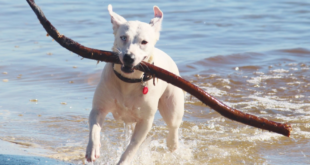Dog Can’t Jump On Bed Suddenly – As pet owners, we often trust our furry friends to bounce up onto our beds with ease. However, what happens when your four-legged companion suddenly loses their ability to make that impressive leap? It can be a concerning situation as we attempt to identify the root cause of the sudden change in behavior. In this article, we take a closer look at why dogs may struggle with jumping on the bed and what steps can be taken to help them regain their capability.
Table of Contents
1. “Bedtime Blues: Why Your Pup Suddenly Can’t Jump On the Bed”
If you’ve noticed your furry pal struggling with jumping onto the bed lately, there might be a few reasons why this sudden change is happening. Here are some things to consider when troubleshooting this behavior:
– Joint Pain: Just like humans, dogs can experience joint pain as they age. If your pup is a senior dog or has a history of arthritis, they might be finding it harder to make the jump without discomfort. You may want to consider investing in pet stairs or a ramp to make it easier for them to access the bed.
– Obesity: If your dog has recently put on extra weight, it might be harder for them to jump onto the bed. An overweight dog may also be at risk for other health issues, so it’s important to consult with your veterinarian about proper diet and exercise routines.
– Anxiety: Dogs can experience anxiety in a variety of situations, and bedtime is no exception. If you notice your pet pacing, panting, or acting nervous when it’s time to go to bed, they might be feeling anxious about jumping onto the bed. This could also be a sign of separation anxiety or other behavioral issues that may need to be addressed by a professional.
It’s important to pay attention to your dog’s behavior and make adjustments as needed to ensure their safety and comfort. Don’t be afraid to seek advice from your veterinarian or a professional dog trainer if you need help addressing this issue.
2. “The Struggle is Real: Understanding Your Dog’s Sudden Inability to Jump”
There are many reasons why your furry friend might suddenly be struggling to make those high jumps that they used to ace with ease. It’s important to understand the root of the problem before deciding on any solutions.
One possible reason for your dog’s inability to jump is arthritis or joint problems. These conditions can make movement painful and difficult, especially when it involves the strain of jumping. If you suspect this might be the case, it’s important to take your dog to the vet for an evaluation and possible treatment options.
Another possible cause could be weight gain or loss of muscle mass. If your pup is carrying excess weight, it can put a lot of strain on their joints, making jumping difficult. On the other hand, loss of muscle can also lead to decreased strength and jumping ability. It’s important to help your dog maintain a healthy weight and exercise routine to keep them in tip-top shape.
Remember that every dog is different and may have unique reasons for their struggles, so it’s always best to consult with your vet to ensure the best possible outcome for your furry friend.
3. “The Puzzle of the Pup: Investigating the Causes of Sudden Jumping Inactivity”
Possible content for section 3:
As we observed in our previous section, some puppies may suddenly become inactive and reluctant to move or play, even though they were previously active and playful. This behavioral change can be puzzling and concerning for their owners, who may wonder if their pet is sick, injured, or unhappy.
To investigate the potential causes of such sudden jumping inactivity in puppies, we need to consider several factors and gather more information. Here are some possible hypotheses and questions that we can explore:
- Physical discomfort: Is the puppy experiencing any pain or discomfort that may prevent them from jumping or moving? Have they recently had any injuries or medical conditions that could affect their mobility? Are they feeling too hot or too cold, or hungry or thirsty?
- Mental or emotional stress: Has the puppy been exposed to any new or stressful situations, such as loud noises, unfamiliar people, or a change in routine or environment? Are they feeling anxious, scared, or bored?
- Misunderstood communication: Is the puppy trying to communicate something to us that we may not understand or notice? Are they asking for attention, affection, or play in a different way than what we expect or recognize?
By examining each of these factors and observing the puppy’s behavior and body language, we can start to piece together the puzzle of the pup’s sudden jumping inactivity. We may need to consult a veterinarian, a dog behaviorist, or other experts to help us identify and address the underlying causes. However, by being patient, curious, and attentive to our puppy’s needs and signals, we can also deepen our bond and understanding with them, and enhance our mutual happiness and well-being.
4. “From Fido to Frustration: Coping with Your Dog’s Sudden Limitations”
When your furry companion suddenly develops limitations, it can be a frustrating experience for both of you. Whether it’s due to aging or an unexpected health issue, these restrictions require you to adjust your care and provide additional support. Here are some tips to help you cope with your dog’s sudden limitations:
– Consult with your veterinarian: Your first step should be to consult with your veterinarian. They can provide information on your dog’s condition, treatment options, and any necessary lifestyle changes. Don’t be afraid to ask questions, as this will help you better understand how to care for your pup.
– Modify their environment: If your dog is having mobility issues, consider modifying their environment to make it safer and easier for them to navigate. This could include installing ramps or rails, rearranging furniture, or adding pet stairs.
– Adjust their diet and exercise routine: Depending on their condition, your dog may need to adjust their diet and exercise routine. Be sure to follow your veterinarian’s recommendations and remember to keep them active, even if it means finding alternative low-impact activities.
While coping with your dog’s limitations can be frustrating, remember that they still rely on you for love and support. With proper care and attention, you can help them maintain a happy and healthy life.
5. “Taking a Leap of Faith: How to Help Your Dog Overcome Sudden Jumping Obstacles
If your dog suddenly encounters a jumping obstacle, it’s important to stay calm and help them conquer their fear with positive reinforcement. Here are some tips to assist your furry friend in taking a leap of faith and overcoming their fears.
1. Start with low obstacles: Begin with small obstacles, such as a low hurdle or a small pile of logs. Once your dog feels comfortable jumping over them, gradually increase the height and difficulty of the obstacles.
2. Use positive reinforcement: Encourage your dog with treats, praise, and playtime when they successfully jump over an obstacle. This will help build their confidence and motivate them to continue trying.
3. Keep training sessions short: Dogs can quickly become overwhelmed, so keep training sessions brief and enjoyable. Allow plenty of breaks for play and relaxation.
Remember, every dog is different and may require individualized training to help them overcome their fears. But with patience, practice, and positive reinforcement, you can help your furry friend conquer their jumping obstacles and gain confidence.
So, if your four-legged friend is now refusing to climb into bed with you but hasn’t always, there may be several causes behind this strange behavior. Remember, a little bit of patience and understanding can go a long way in getting to the bottom of why your pup has gone off their nightly jumping routine.
 Treat For Dog – Brain Training for Dogs, Dog Training & Obedience Discover Treat For Dog and get your pup on the path to smarter, happier, and healthier living with brain training for dogs.
Treat For Dog – Brain Training for Dogs, Dog Training & Obedience Discover Treat For Dog and get your pup on the path to smarter, happier, and healthier living with brain training for dogs.




